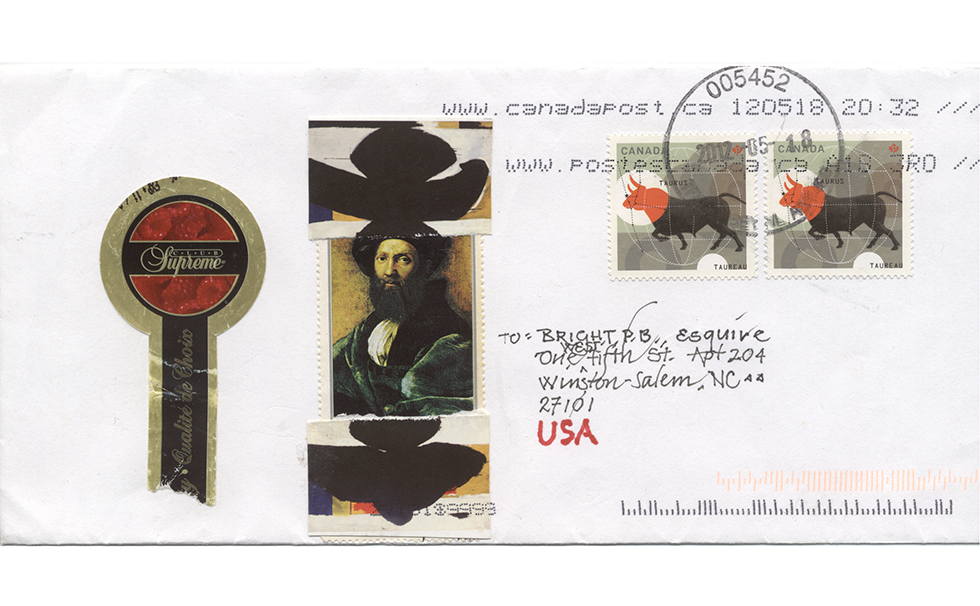Ros-en-velopes

Ros-en-velopes
missives and enclosures from James Rosen
FEBRUARY 6 – MARCH 31, 2014
There couldn’t have been a more perfect means invented for the transmission of James Rosen’s thoughts and ideas, written or drawn, than the paper envelope. The double-entendre envelope/envelop reflects the duality of being both an object as well as an action, very much like Rosen’s paintings, which are objects that enclose, but that also act to disclose their contents in a process of unveiling in the presence of a reader or, in Rosen’s words, a “capable observer.” The envelopes and their contents, however, offer a closer view of Rosen’s personality than his paintings do, and allow him to express his thoughts as directly as he can.
Ros-en-velopes are characterized by their unselfconsciously intimate nature, of being addressed to a single recipient and containing images and ideas specifically for them. The web of the trajectories traced by these mostly one-way flights is not a primary consideration for James Rosen; it’s a result rather than a raison d’etre. The letters are filled with tidings and potent ideas. They sometimes contain drawings, exhortations, poems, or aphoristic thought-fragments that read like poetry. The images are, inside and out, often delightful, or humorous, and sometimes surprisingly realized. But receiving one of his letters can also evoke a certain trepidation. The ideas transmitted by his distinct and deliberate hand, are, like that calligraphy, themselves beautiful, but often difficult to decipher. The contents can sometimes be involuted, but also nearly urgent in their acuity, vehemence, or affection. These missives are generous reminders that gifts carry weight and responsibility.
While not intentionally created to be, these multiple correspondences form a large, ongoing, convoluted work of art organically weaving in space and across time – a diachronic work, as Rosen might say. It resembles the music of two composers who interest Rosen; Morton Feldman and John Cage, in a conflation of their approaches, where time is elastic and where interesting things happen in the intervals between intentional events. The time it takes for a letter to make the transit from James Rosen to one of his recipients seems to allow a “transition”, a necessary gestation; for understanding any of Rosen’s work, whether paintings or envelopes, takes time and effort proportional to the ideas and processes behind them.
While it is important to understand that none of these “missives or enclosures” were created for anyone other than the recipient, and certainly without the intention that they would be exhibited publicly as a group, it feels as if Rosen had some unspoken plan that he would reveal only through occasional indirect suggestions, with the ultimate goal of having everyone important to him coalesce, however briefly, in one place. This convergence of Ros-en-velopes only partially and metaphorically achieves that. But it does connect the recipients, revealed through these peripatetic fragments of Rosen’s thinking, his seeing, his making. It is hoped that these relationships – of people, images, words and ideas – will likewise pleasurably entangle the viewer.
About the Artist
James Rosen was born December 3, 1933 in Detroit, Michigan. He studied at Cooper Union, Wayne State University, and Cranbrook Academy of Arts. He was a professor of art history and painting at the University of Hawaii, University of California-Berkeley, Santa Rosa Junior College, and Augusta College where he was the William S. Morris Eminent Scholar in Art. He has been Artist/Critic with the Pennsylvania Academy of Fine Arts.
Some of his solo exhibitions include: The Artist and the Capable Observer, MOCRA, St Louis, 2010-11; Emulous Lustres, Hanes Art Gallery, Wake Forest University/Rocca di Cento, Cento, Italy/Galeria del Carbone, Ferrara, Italy, 2006-07; Gallery Paule Anglim, San Francisco, 2003; Timken Art Museum, San Diego, 1991; Galleria Civica d’Arte Moderna, Ferrara, Italy, 1986; Betty Parsons Gallery, New York, 1980. Group exhibitions include: Homage to Betty Parsons, New York, 1999; Newfoundland Drawings, Baird Gallery, Canada, 1999; Faculty Exhibition, Museum of American Art, Philadelphia, 1998; On the Edge, Rosa Esman Gallery, New York, 1990; American Watercolors, San Diego Museum of Art, 1983; Spring Penthouse Show, Museum of Modern Art, New York, 1973.
His work is included in the collections of the Metropolitan Museum of Art, Museum of Modern Art, and the Whitney Museum of American Art in New York; Palazzo Schifanoia, Ferrara, Italy; San Diego Museum of Contemporary Art; Victoria and Albert Museum, London; San Francisco Museum of Modern Art; Cranbrook Museum of Art Museum; and Arizona State University Art Museum.
Among his grants, awards, residencies, and honors is included the Artist Residency, Fundacion Valaparaiso, Spain, 2002; Visiting Artist/Critic and Lecturer, Hope College, Michigan, 1998; Artist of the Year, Phi Kappa Phi, Louisiana,1997; Director, the Meyer Schapiro Fund, Augusta State University, Georgia, 1996; Artist in Residence, Galleria Civica d’Arte Moderna, Ferrara, Italy, 1984; Djerassi Foundation Fellowship in Painting, Woodside, California, 1983, among others. His essays, art criticisms, and lectures have been included in a variety of publications.
Curator
Paul Bright, Charlotte and Philip Hanes Art Gallery Director
Reception
Thursday, February 20 5-7 PM
Related Programs
Posted: Artists and Letters / Talk by Paul Bright
Tuesday, March 4, 5 PM
Microfiction: Unrecognized Literature of Everyday Life
Monday, March 24, 7 PM
Correspondences: A Conversation with Jim Rosen
Monday, March 31, 5 PM
Related Links
- Ros-en-velopes: envelopes and enclosures by James Rosen (Exhibition Essay)
- “Ros-en-velopes: Missives and Enclosures from James Rosen” at Hanes Gallery (WFDD – Triad Arts)
- Posted: Artists and Letters / Talk by Paul Bright(ZSR Lecture Series)

